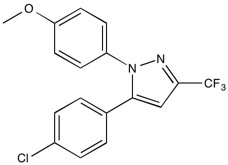SC-560 | Selective COX-1 inhibitor
NMR (Conforms)

Available Options
| Size: | Price | Quantity | |
|---|---|---|---|
| $50.00 | |||
| $195.00 |
SC-560 (188817-13-2) is a highly selective (700-fold selective over COX-2) and potent (IC50 = 9 nM) inhibitor of cyclooxygenase-1(COX-1).1 SC-560 inhibited TNF α-induced PGE2 synthesis in neurons and, PGE2 and thromboxane A2 synthesis in human monocytes and platelets (IC50’s = 1.8 nM and 2.5 nM respectively) indicating non-selective COX inhibition. SC-560 was able to inhibit PGE2 synthesis in COX-1-deficient neurons indicating a COX-1 independent mechanism. This unselective COX inhibition was only observed in whole cells – it remained COX-1 specific in cell lysates.2
References/Citations:
1) Smith et al. (1998), Pharmacological analysis of cyclooxygenase-1 in inflammation; Proc. Natl. Acad. Sci. USA 95 13313
2) Brenneis et al. (2006), Inhibition of prostaglandin E2 synthesis by SC-560 is independent of cyclooxygenase 1 inhibition; FASEB J. 20 1352
NMR (Conforms)
Safety Data Sheet:
Product Data Sheet:
Materials provided by Focus Biomolecules are for laboratory research use only and are not intended for human or veterinary applications. Please note that we do not sell to individuals and that all orders placed by non-research organizations will incur a $20 restocking/refund fee
SC-560 (188817-13-2) is a highly selective (700-fold selective over COX-2) and potent (IC50 = 9 nM) inhibitor of cyclooxygenase-1(COX-1).1 SC-560 inhibited TNF α-induced PGE2 synthesis in neurons and, PGE2 and thromboxane A2 synthesis in human monocytes and platelets (IC50’s = 1.8 nM and 2.5 nM respectively) indicating non-selective COX inhibition. SC-560 was able to inhibit PGE2 synthesis in COX-1-deficient neurons indicating a COX-1 independent mechanism. This unselective COX inhibition was only observed in whole cells – it remained COX-1 specific in cell lysates.2
References/Citations:
1) Smith et al. (1998), Pharmacological analysis of cyclooxygenase-1 in inflammation; Proc. Natl. Acad. Sci. USA 95 13313
2) Brenneis et al. (2006), Inhibition of prostaglandin E2 synthesis by SC-560 is independent of cyclooxygenase 1 inhibition; FASEB J. 20 1352
Calculate the molar concentration, mass or volume in a solution.
Concentration × Volume × Molecular Weight = Mass
Focus Biomolecules • Plymouth Meeting, PA USA • 1-855-FOCUS21
Focus Biomolecules
Plymouth Meeting, PA USA
1-855-FOCUS21
Website Created by Advanta Advertising LLC.

